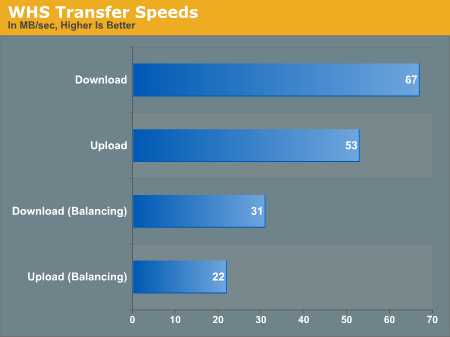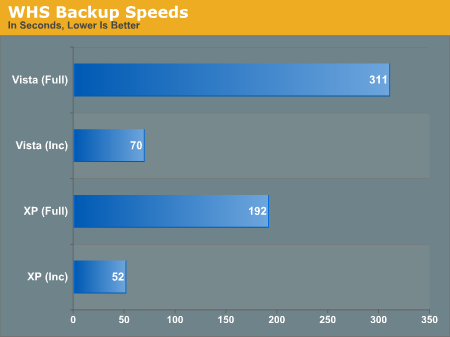A New Kind of Home Computer: Windows Home Server Preview
by Ryan Smith on September 4, 2007 1:00 PM EST- Posted in
- Systems
Performance Data
Because we were only able to get our hands on a release candidate version of WHS for the performance testing, all the results here need to be taken with a grain of salt. The WHS RC is quite good, especially in comparison to rockier launches like Vista, but we expect the performance numbers in particular to have changed slightly between the RC and the final version.
It's worth noting that the network packet throttling problem with Vista is still in play as of this writing. As a result all of our tests are under Windows XP SP2 unless otherwise noted, and when they're run on Vista it is with Multimedia Class Scheduler Service disabled to prevent throttling. Although this problem has existed in Vista since it has shipped, this is about the worst time it could come to light for Microsoft. Until it's fixed, Vista users wanting to move their media off of a personal computer and onto a WHS server will definitely want to hold off on doing so. Even though the problem with throttling isn't one with WHS, the problem occurring in Vista still drags down WHS.
| Client Test Bed | |
| Processor | Intel Core 2 Quad QX6850 (3.00GHz/1333MHz) |
| RAM | G.Skill DDR2-800 (2x2GB) |
| Motherboard | Gigabyte GA-P35-DR3R (Intel P35) |
| System Platform Drivers | Intel 8.1.1.1012 |
| Hard Drive | Maxtor MaXLine Pro 500GB SATA |
| Video Cards | 1 x GeForce 8800GTX |
| Video Drivers | NV ForceWare 163.44 |
| Power Supply | OCZ GameXStream 700W |
| Desktop Resolution | 1600x1200 |
| Operating Systems | Windows Vista Ultimate 32-Bit Windows XP SP2 |
| . | |
| Server Test Bed | |
| Processor | AMD Athlon X2 4600+ (2.40GHz/400MHz) |
| RAM | OCZ DDR-400 (4x512MB) |
| Motherboard | ASUS A8N-SLI Premium (nForce 4 SLI) |
| System Platform Drivers | NV 6.69 |
| Hard Drive | 2x Western Digital Caviar Raid Edition 2(400GB) |
| Power Supply | OCZ GameXStream 700W |
| Operating Systems | Windows Home Server RC |
| . | |
We'll start with testing WHS's file server abilities by transferring files back and forth. With a gigabit network, the bottleneck will be the transfer abilities of our hard drives, so if WHS is achieving maximum performance it should be able to move data at speeds around the maximum of our hard drives. We'll be using a RAM disk on the client side to isolate the performance of WHS.
Also on this graph will be the performance of WHS while attempting to do file transfers in the middle of a balancing operation. Because of the importance in balancing data for data retention and performance reasons, WHS will sometimes need to balance folders even during times of backups and file transfers. This doesn't seem very common in our use since it's related to total use of the WHS server, but it needs to be noted all the same. WHS does seem to take steps to avoid balancing during heavy use when possible.

At 53MB/sec up and 67MB/sec down, the results are very close to those that we've seen WD RAID edition hard drives do previously. For users with gigabit networks, it looks like it's very possible for WHS to offer performance virtually equal to having the drives installed locally. Speeds while balancing aren't very impressive though, not that we expected them to be.
The other metric of WHS's performance is how it handles backups. Unlike pure file transfers, backups aren't "brain-dead" operations and require work on behalf of both the server and the client. The client needs to figure out what data is to be sent to the server, and the server is responsible for keeping all of that data organized and compressed. WHS backup performance is also heavily dependent on what else is already in the backup cache, because WHS avoids backing up anything redundant down to the cluster level.
These specific tests were run with empty caches as a worst-case scenario; actual performance of the initial backup on a new machine (as long as it's not the first machine) should be faster. These tests are being done on clean Windows installations, with the second "incremental" backup being done immediately after the first backup completes. This is more optimistic than a real incremental backup since virtually no data changes, but in doing it this way we can establish a floor for approximately how long the scan process takes. The reference sizes for these installations are 2.3GB for XP and 5.4GB for Vista, after factoring out the system page file and other files that WHS backup filters out.

Both Vista and XP turn in respectable, although not amazing backup times. Using the incremental backup as the baseline, we achieved an average backup speed of about 20MB/sec. This is well below what we've seen on our file transfer tests, but still fast enough to complete these backups in a short amount of time; since WHS doesn't have any true peers we don't have anything else to properly compare it to. In an actual deployment with real incremental backups and common data, we expect the results to be a lot closer to that of the incremental times.
We also took the liberty of backing up the XP machine again once the Vista machine was backed up in order to measure the size of the backup cache on the WHS server. Even with these clean installs, there's about 2GB of savings on the WHS server; 7.7GB of data is only taking up 5.7GB of space. Like Previous Versions on Vista, these savings should grow as more data is added to the backup cache.










128 Comments
View All Comments
mindless1 - Wednesday, September 5, 2007 - link
Surely the backup client can be disabled (On one of the two)? I would be very surprised if 2 WHS systems can't coexist given a configuration change if you just wanted to avoid the wasted redundancy of having both make backups. That is, unless MS had deliberately chosen to prevent the two from getting along.ATWindsor - Tuesday, September 4, 2007 - link
Does it souppert proper raid, like raid 5 for instance? That fits my use a bit better than this duplication of files. WHS looks interesting, but seemingly a bit to primitive to be honest, seems to be missing quite a few more or less nescessary features.Rolphus - Tuesday, September 4, 2007 - link
The choice of OS should be entirely separate to RAID considerations. Software RAID5 is a bit of a waste of time, seeing as any performance advantage over just mirroring the data would be more than offset by software parity calculations. I don't see any reason why a BIOS-level RAID system (as supplied by many high-end and server motherboards and add-in cards) wouldn't be supported by WHS; Windows 2003 Server supports any RAID level you care to throw at it.mindless1 - Wednesday, September 5, 2007 - link
Most people won't care about parity calculation overhead, it's not as though the system is being used like a PC or workstation, that's practically ALL the system would be doing besides sitting idle, particularly given the rough spec of a 1GHz or more processor which is not at all needed just to serve files. Maybe with GbE, you might want a 300-400MHz processor to keep networking performance good but on a system that old you'd probably be bottlenecked by the PCI bus before anything else.yyrkoon - Wednesday, September 5, 2007 - link
What is wrong with software RAID, if that is all the system does(server storage) ? In my book, implementing *any* so called server OS *needs* to have at least RAID1, and should have RAID5 in software. If not, there is not realy reason to stop using WinXP Pro, with a few registry hacks tp bypass the RAID5 limitation.Anyhow, why pay for something that is lacking when you can get an OS that does it for free, or another earlier version of windows that will do it with a few hacks, and yu're already familiar with.
As I said in an earlier post, I used WHS for a few days several months ago(early beta program), and did not like what I saw. So . . .
ATWindsor - Wednesday, September 5, 2007 - link
Software raid5 can have very good performance, modern computers are fast, besides the main consideration is not wasting so much space, if you want to have som security for your files, you get by on loosing 1/4 insted of 1/2 of the space.The main advantage off WHS is the whole storage-pool-setup, I hope they implment somethin similar in w2k3.
Gholam - Sunday, September 9, 2007 - link
I tested software RAID5 on an nForce4 SLI motherboard (DFI LanParty nF4 SLI-DR) with Silicon Image 3114 chip and 4x WD 500GB drives. Reads were in 11-14MB/s range, writes sub-10MB/s, and CPU load was near full, on an Athlon 64 4000+.ATWindsor - Sunday, September 9, 2007 - link
Try to test a proper software-raid, instead of the inbuilt nforce-crap, just because you tested a poor solution doesn't make all solutions bad.Gholam - Sunday, September 9, 2007 - link
It's not nForce, it's SiI3114, nearly ubiquitous on higher-end motherboards of that era, as well as present on many lower-end PCI cards. Building RAID5 on an "affordable" solution from Silicon Image, Promise and such will give you exactly that kind of performance, as well as guarantee a high probability of data loss due to driver/firmware bug. In order to run RAID5 you need a proper controller from Adaptec/LSI Logic/3Ware, and that costs big bucks.Ryan Smith - Tuesday, September 4, 2007 - link
It only supports proper RAID if you can configure it all in the BIOS. Any kind of softRAID that needs Windows' help isn't supported. Basically it needs to appear as 1 disk to Windows.